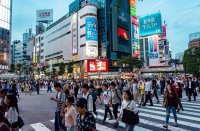Greta Thunberg, 16-year-old Swedish climate activist started massive Friday climate strike that 150 countries joined. The purpose of the march is to call on policymakers to take overdue steps against climate change as part of global strike before United Nations Climate Action Summit set to begin in New York on 23 September. On 20 September, over 5000 participants joined into the climate change strike.
Justin Trudeau met with the 16-year-old Swedish climate activist this morning, in his capacity as Canada's prime minister, before Greta Thunberg spoke to the media. They spoke quietly for about 15 minutes. (Ryan Remiorz/The Canadian Press) pic.twitter.com/pNCdb9zAlX
— CBC News Alerts (@CBCAlerts) September 27, 2019
Thunberg has become an increasingly influential figurehead and voice for youth climate angst and activism. She no longer flies because the aviation industry’s high carbon emission, she was offered the opportunity to travel to the US on a zero-emissions sailboat to Washington, DC. She the left for New York City for the strikes and the summit.
She started this movement called Fridays for Future, which goes on strike every Friday to demand more aggressive action from their governments and the international community. According to the Global Climate Strike website, there were 2,500 events scheduled in over 150 countries. People will be protesting to increase awareness of the situation and pressure the governments on local issues.
On 20 September, more than 5,000 participants, including 2,800 students joined the march to call the city to revise its carbon emission reduction goals. Their other request is to ask the appointed Environment Minister Shinjiro Koizumi to show leadership at the U.N. summit and pursue ambitious policies to protect future generations.
A student environmental group helped organized the march on Friday. According to an article written by Japan Times, they interviewed a 16-year-old activist Saori Iwano, a member of Friday For Future Tokyo and she said that “disaster caused by climate change are worsening every year”.
“How many tens of millions of people will have lost their homes by 2050? And What will be left in the year 2100? Our lives, with our families and our loved ones and our future, are being threatened by the climate crisis,” said Saori Iwano during her interview with Japan Times.
Iwano said that “we do not have the right to vote. We do not have money, power or scientific or expert knowledge. That is why we need the help of adults. The climate crisis renders age and occupation irrelevant. What is being asked of you is what you can do as an individual.”
The Tokyo Metropolitan Government is aiming to reduce emission by 30 percent from 2000 levels by 2030. However, the students from the march said this “isn’t good enough”, adding that Tokyo should set more ambitious goals to reduce emission.
The co-founder of Friday for the Future (FFF) Hiroto Inoue said that “friends of the same generation, let alone adults, don’t understand what we are trying to do. [Even though] we raise our voices, the society still will not listen.”
Takuro Kajiwara, an 18year-old student member of FFF pointed out that Japan is lagging behind in the climate change movement saying that “something can be said for the low awareness of social issues among the Japanese general public.”
The country’s minister, Koizumi, who was appointed to his first Cabinet post in September is expecting a child next year. The FFF said that they hoped that Environmental Minister would advocate for younger generations and reconsider the relationship between climate change and economic growth in Japan. Unfortunately, when FFF sent Koizumi an invitation to the march on Friday the minister did not reply.
For your own future and future generations, what can we do? After increasing awareness and alerting the governmental officials, what other steps can we take? Can you be like Thunberg and sacrifice the comfort of flying in order to reduce greenhouse gas emission for the future earth?














































